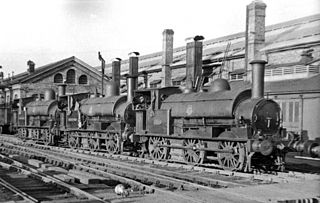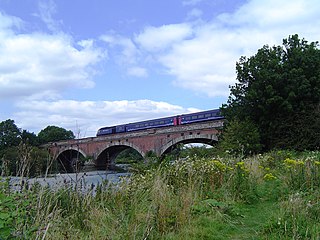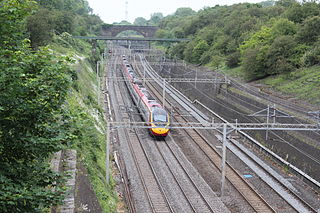
The London and Birmingham Railway (L&BR) was a railway company in the United Kingdom, in operation from 1833 to 1846, when it became part of the London and North Western Railway (L&NWR).

Wolverton railway works, known locally as Wolverton Works or just The Works, was established in Wolverton, Buckinghamshire, by the London and Birmingham Railway Company in 1838 at the midpoint of the 112-mile-long (180-kilometre) route from London to Birmingham. The line was developed by Robert Stephenson following the great success of the Liverpool and Manchester Railway line.

Moulsford Railway Bridge, also known locally as "Four Arches" bridge, is a pair of parallel bridges located a little to the north of Moulsford and South Stoke in Oxfordshire, UK. It carries the Great Western Main Line from Paddington, London to Wales and the West across the River Thames. The bridge lies between the stations at Goring & Streatley and Cholsey, and crosses the Thames at an oblique angle on the reach between Cleeve Lock and Benson Lock.

A skew arch is a method of construction that enables an arch bridge to span an obstacle at some angle other than a right angle. This results in the faces of the arch not being perpendicular to its abutments and its plan view being a parallelogram, rather than the rectangle that is the plan view of a regular, or "square" arch.

The River Irwell Railway Bridge was built for the Liverpool & Manchester Railway (L&MR), the world's first passenger railway which used only steam locomotives and operated as a scheduled service, near Water Street in Manchester, England. The stone railway bridge, built in 1830 by George Stephenson, was part of Liverpool Road railway station. The bridge was designated a Grade I listed building on 19 June 1988.

Linslade Tunnel is a railway tunnel in Bedfordshire, England, on the West Coast Main Line about 0.54 miles (0.9 km) north of Leighton Buzzard railway station and built under Linslade Woods. Consisting of three individual bores, the tunnel is somewhat unusual as there is a slight bend in its alignment.

Roade Cutting, also known as Blisworth Cutting, is a railway earthwork and 15.2-hectare (38-acre) geological Site of Special Scientific Interest along the West Coast Main Line north from Roade in Northamptonshire, England. It is a Geological Conservation Review site.

Primrose Hill Tunnel is a 1,164-yard (1,064 m) railway tunnel on the West Coast Main Line, approximately 2 miles (3.2 km) from Euston station. It is located in South Hampstead in the London Borough of Camden, just north of Primrose Hill park and consists of two bores: the slow line to the northern side, driven through the London clay by the engineer Robert Stephenson for the London and Birmingham Railway in 1838, and the fast line to its south, added by the London and North Western Railway in 1879. The original tunnel's Italianate portals were designed by William Budden and later replicated for the fast line. The western portals have been listed at Grade II and the eastern at Grade II* since 1974.

The Wolverton Works canal bridge, or Bridge no. 171C, is a bridge over the Grand Union Canal in Wolverton, Milton Keynes in south-eastern England. It carries a spur from the West Coast Main Line into Wolverton Works. It was built in 1834–1835 for the London and Birmingham Railway under the supervision of Robert Stephenson and has been little modified since. It is a grade II* listed building.

Brandon Viaduct is a railway viaduct crossing the River Avon between the villages of Brandon and Wolston in Warwickshire. It carries the Birmingham Loop line and is roughly halfway between Rugby and Coventry. The bridge was built in around 1835 for the London and Birmingham Railway and is now a grade II listed building.

The Sowe Viaduct is a railway bridge on the Birmingham Loop line crossing the River Sowe at the south-eastern edge of Coventry in central England. Built in 1838, it is a Grade II listed building.

The Sherbourne Viaduct is a railway bridge that carries the Birmingham Loop line across the River Sherbourne in Coventry, central England. Built in 1838, it is a grade II listed building.

Mile Lane Bridge is a road-over-rail bridge in Coventry, central England. It is possibly the first use of a flying arch over a railway cutting and is a Grade II listed building.

Wolverton Viaduct is a railway bridge carrying the West Coast Main Line over the River Great Ouse to the north of Wolverton, part of Milton Keynes, in south-eastern England. Built in 1838 for the London and Birmingham Railway (L&BR) to the design of Robert Stephenson, it was the largest viaduct on the L&BR's route. It is in the centre of Wolverton Embankment, itself the largest on the line. It has six brick arches and covers a distance of 660 feet, reaching a maximum height of 57 feet above the river, and terminating in substantial abutments which contain decorative arches. The viaduct and embankment feature in drawings by John Cooke Bourne. Several contemporary commentators likened Stephenson's bridges to Roman aqueducts. Some modern engineers and railway historians have suggested that Wolverton Viaduct is not as innovative or impressive as some that followed but nonetheless praised its visual impact.

The Blisworth Arch is a railway bridge in Blisworth, Northamptonshire, in eastern England. It was designed by Robert Stephenson for the London and Birmingham Railway and completed in 1837. It is a grade II listed building and a significant local landmark.

Bushey Arches Viaduct is a railway bridge on the West Coast Main Line immediately north of Bushey railway station, between Bushey and Watford, in Hertfordshire, Eastern England, just north-west of London.

Abbots Langley railway bridge, also known as the bridge over Railway Terrace is a skew bridge carrying the West Coast Main Line over a road near Abbots Langley, Hertfordshire, in Eastern England. The angle of the bridge creates a 25-metre (82-foot) tunnel along the road. It was built in 1837 and is a Grade II listed building.

Tring Cutting is an earthwork on the southern part of the West Coast Main Line on the Hertfordshire–Buckinghamshire boundary near Tring in southern England. It was built for the London and Birmingham Railway to the specification of Robert Stephenson and opened with the line in 1837. The cutting is 2.5 miles long and has an average depth of 40 feet but reaches 60 feet at some points, making it one of the largest engineering works on the London and Birmingham's line. Three bridges that cross the cutting were built at the same time as the line and are listed buildings.

Denbigh Hall railway bridge carries the West Coast Main Line railway across Watling Street just north of Bletchley, Milton Keynes, in southern England. It dates from the opening of the London and Birmingham Railway in 1838 and was designed by Robert Stephenson though it has been heavily modified. It is a Grade II listed building.
Blue Bridge was built in the 1830s to span the London and Birmingham Railway (L&BR) (now the West Coast Main Line near Wolverton Works in Buckinghamshire, southern England. It was designed by Robert Stephenson, the L&BR's chief engineer and extended in the 1880s when the line was widened. It is a Grade II listed building. When a modern bridge was built alongside, it continued in use for a time as a shared path but, after being declared unsafe, is no no longer open for use.




















